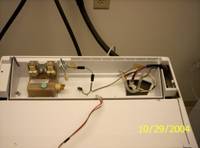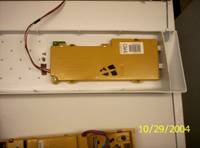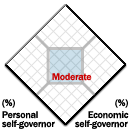 These washers have been out for a few years and I’m starting to see more of them in the field. They are extremely reliable machines. Although they’re designed for residential use, I’ve seen them used in commercial applications, sustaining daily, continuous use for several years. This is a top loading machine, vertical axis, and uses an agitator like most top-loaders. These pictures are all from a model GWL08, which has been out for several years. The current model is GWL11.
These washers have been out for a few years and I’m starting to see more of them in the field. They are extremely reliable machines. Although they’re designed for residential use, I’ve seen them used in commercial applications, sustaining daily, continuous use for several years. This is a top loading machine, vertical axis, and uses an agitator like most top-loaders. These pictures are all from a model GWL08, which has been out for several years. The current model is GWL11.
The most common problem I’ve seen with these washers is a failed pump. The pump is a separate electric pump, is very easy to change by laying the washer down on it’s front panel, and is reasonably priced (about $50). Changing the pump is about a 10-minute job, and that includes time to manually bail a tub full of water.
Although it’s a top-loader and looks very similar to any other top-loading washing machine you’ve seen, it has some significant design differences.
This machine uses a DC drive motor and performs spin and agitate by directly controlling the motor–no transmission! This has three big advantages over conventional top-loaders: 1) increased energy efficiency since you don’t have efficiency losses through a transmission, 2) better reliability since there’s no transmission to fail, and 3) no belts to fail since the agitator is connected directly to the motor shaft.
The control panel lifts off by removing two phillips screws on the back of the control panel. The panel then flips over. The picture below shows what it looks like with the control panel removed.

Control Compartment with Touchpad Lifted Off and Power/Pressure Module Removed (note the water inlet valves on the left-hand side)
Not shown above are Power Control and Pressure Sensing Module, which plugs into the water inlet valve nipple, and the tech sheet, which you’ll find folded up to the left of the water inlet valve. The tech sheet gives detailed instructions for entering diagnostic mode and interpreting the binary diagnostic code generated by the LED display on the control panel touch pad.
The Power Control and Pressure Sensing Module has been removed in the picture above. It’s shown below:

Power Control and Pressure Sensing Module
Another difference with this machine is that it has no discreet pressure switch. Tub fill level is sensed by the Power Control and Pressure Sensing Module, above. This module has two fuses inside, on the control board. When one of them blows, it’s usually an indication that one of the high voltage components, pump or diverter valve, have gone bad. Surprisingly, and contrary to our experience with the abysmal Maytag Neptune Machine Control Board, this control board is amazingly robust. The board on this particular washer happened to be bad but that’s the first one I’ve seen.
The air tube from the tub pressure dome connects to a nipple on the upper right-hand side of the module. The module has a female port that connects with the water inlet valve nipple making a water-tight connection. Water is run into a heat sink tube inside the control board module to keep it cool. It’s the only water-cooled control board I’ve ever seen in the appliance world!
This last picture shows the Touchpad Module that accepts and interprets keypad input.

Touch Pad Module–Located on the Backside of the Touchpad
I haven’t seen any failures of this module. I have however, seen the touchpad itself fail but, in almost every case, it’s from the user pushing too hard on the keypad buttons. But, it’s a very inexpensive and easy part to replace.
Nice machine, as you’d expect from Fisher & Paykel–reliable, first-rate engineering, and easy to troubleshoot and repair.

















